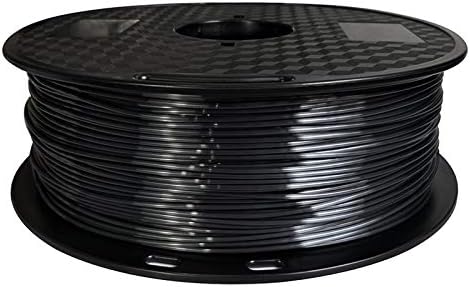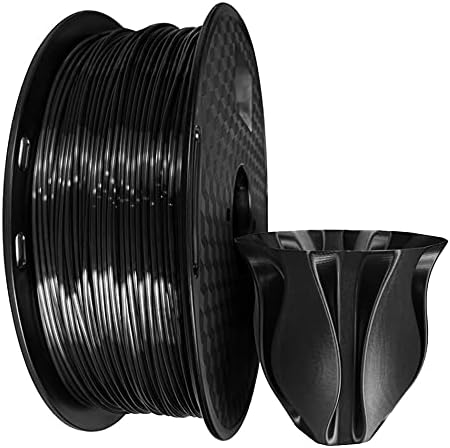Page Contents
Details: FARUTA PLA 3D Printer Black Filament 1.75mm 250g/500g/1Kg 3D Printing Filaments Materials Supplies (Color : Silk Black 500g)
Brand: FARUTA
Welcome to our store, we will continue to update our products, thank you for your attention, and hope you have a good day~Specifications:Material:PLAColor: As the picture showsPrinting Temperature:190 C-240 C (374 F-446 F)Recommended Printing Speed: 30 – 60 mm/sDensity: 1.25±0.05g/cm3Size:1.75mm+/-0.05mmHeated Bed Temperature: 0-50°CWeight: 250g 500g 1KG Can Choose (PLA Filament Net Weight)Package Included: 250g/500g/1Kg 3D Printing Filaments Note:1. Due to the different monitor and light effect, the actual color of the item might be slightly different from the color showed on the pictures. Thank you!2. Please allow 1-3cm measuring deviation due to manual measurement.
Advantages
- Products can be returned
- Size:1.75mm+/-0.05mm
- Material:PLA
- Heated Bed Temperature: 0-50°C
- Density: 1.25±0.05g/cm3
- Weight: 250g 500g 1KG Can Choose (PLA Filament Net Weight)
Notice
- Is an online purchase
- Delivery may be delayed in some areas.
Buyer Guide 3D Printing Supplies
It’s always a good idea to have a firm understanding of each individual component, and go from there.- Filament, or “muck.” The filament is a plastic used in 3D printing. It’s usually available in different diameters and colors.
- Printer. There are different kinds of 3D printers, including desktop, industrial, and open-source models.
- Software. There are several different types of printing software, including slicers, slicer-creator, and hosts.
- Support Material. Support material is a support material used in 3D printing. There are usually 2 types: soluble support material and solid support material
- PLA (Polylactic acid): PLA filament is biodegradable, renewable, and compostable.
- ABS (Acrylonitrile butadiene styrene): ABS filament is stronger, tougher, and better than PLA.
How to choose 3D Printing Supplies
When shopping for 3D Printing supplies, there are several factors that you should keep in mind:Is the 3D printer compatible with your
computer? Some 3D printers require special software, while others require
their own proprietary software. Some printers work with only Mac computers,
while others work with only Windows computers.
What materials will you use?
3D printers work with hundreds of materials, including polymers, metals,
porcelain, glass, and ceramics.
What are your needs?
Some 3D printers are better than others for specific types of uses. You
may want to look for a 3D printer that will handle small objects, large
objects, or both.
How much will you spend?
3D printers can cost thousands of dollars or a few hundred.
How large is the 3D printer?
3D printers come in all shapes and sizes. Some smaller printers work well
as desktop models, whereas bigger 3D printers can be used for large
spaces.
How large will your print be?
Some 3D printers can handle large prints, while some can only handle
small print jobs.
How fast will your 3D printer print?
3D printers are rated by how fast they print, and the speed will vary
depending on your needs. Some 3D printers print at a rate of several
inches per second, while others print at a rate of inches per hour.
Will you be printing outdoors or indoors?
Some 3D printers work best indoors, while others are best used outdoors.
How to maintain 3D Printing Supplies
3D printing is a new technology that is changing the way people create and engineer new products.- To clean the filament, use soap and water to wet your filament, then wipe it dry with a paper towel.
- To clean the nozzles, wipe them with a damp rag.
- To clean the build plate, wipe it with a clean, lint-free cloth.
- To clean the extruder, use compressed air.
- To clean the build plate, first, remove any building material or part from the plate. Then, use a paper towel or paper towel moistened with rubbing alcohol to wipe off the build plate.
- To clean the extruder, first, unplug the extruder from the 3D printer. Then, moisten a paper towel or paper towel with rubbing alcohol and wipe down the extruder.
- To clean the 3D printer, use compressed air to blow loose dust out of the printer.
- To clean the filament, use compressed air to blow loose dust out of the filament.
- To clean the nozzle, use compressed air to blow loose dust out of the nozzle.
- To clean the build plate, use compressed air to blow loose dust out of the build plate.
- To clean the extruder, use compressed air to blow loose dust out of the extruder.
- To clean the filament, unplug the extruder from the 3D printer and use compressed air to blow loose dust out of the filament.
- To clean the nozzle, unplug the nozzle from the 3D printer and use compressed air to blow loose dust out of the nozzle.




